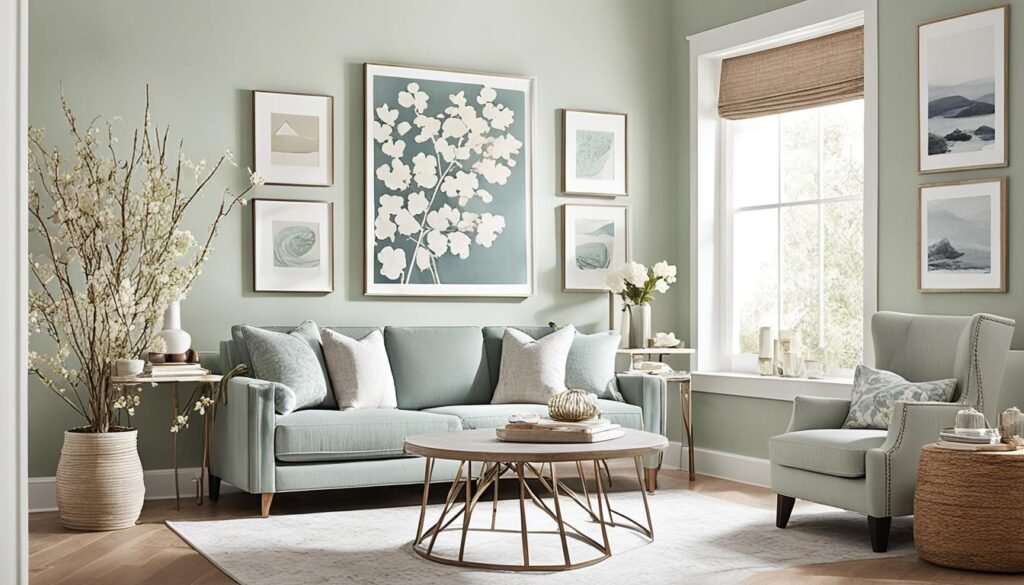Discover the Charm of Muted Colors in Design

Colors breathe life into designs, evoking emotions and shaping experiences. Muted colors, also known as subdued hues or soft tones, go beyond aesthetics. They convey brand identity and set the tone for user communication.
These desaturated palettes and mellow tints have an understated appearance with dull pigment. They create a sense of sophistication and tranquility in designs. Muted colors offer several benefits in design projects.
They produce a serene atmosphere and visual harmony. This allows other design elements to stand out prominently. Subdued hues also complement various design disciplines, from branding to interior design.
Key Takeaways
- Muted colors exude a sense of sophistication and tranquility, setting the tone for brand identity and user experience.
- Leveraging muted color palettes can create a serene and harmonious atmosphere, allowing other design elements to shine.
- Subdued hues offer versatility, complementing a wide range of design disciplines, from branding to interior design.
- Muted tones can evoke emotions and promote user comfort, particularly in digital environments prone to “screen fatigue”.
- Carefully curated muted color schemes can achieve visual harmony and timeless appeal in design.
Introduction to Muted Colors
Colors can stir emotions and shape user experiences. Muted colors, also called desaturated or subdued hues, are vital for creating captivating digital journeys. These colors are softened by adding gray or a complementary color, reducing their brightness.
Colors’ Impact on Design and User Experience
Muted colors create a sense of sophistication and tranquility. They often have a vintage or nostalgic vibe. These versatile hues have gray or black undertones, offering a soft presence.
Muted colors align closely with neutral tones. They have a calming effect and feel safe, familiar, and nurturing. In design, they’re seen as modern and genuine.
What are Muted Colors?
Muted colors have low saturation or chroma. They’re created by adding black, white, or complementary colors to a base color. Unlike pastels, muted colors have a more subdued appearance due to gray undertones.
Examples of muted colors include butter yellow, sage green, and lilac. Pale blue, light brown, terracotta, and dusty rose are also muted colors.
| Muted Color | Description |
|---|---|
| Butter Yellow | A soft, creamy yellow with a subtle gray undertone |
| Sage Green | A muted, earthy green with hints of gray and blue |
| Lilac | A soft, grayish-purple hue with a delicate, soothing quality |
| Pale Blue | A calming, tranquil blue with a touch of gray |
| Light Brown | A warm, neutral brown with a muted, natural appearance |
The Allure of Muted Color Palettes
Muted color palettes offer a sophisticated and serene alternative to vibrant hues. These subdued tones evoke calm and balance across various design disciplines. They captivate designers in graphic design, interior decor, fashion, and web development.
Serene and Sophisticated Aesthetics
Muted colors create a serene and sophisticated atmosphere. Designers blend hues with subtle shades of gray or complementary tones. This creates visually harmonious palettes that soothe the senses and promote tranquility.
Muted color schemes often draw inspiration from nature. They feature earthy tones like muted greens, browns, and beiges. These colors exude a timeless, organic charm.
Versatility across Design Disciplines
Muted color palettes are remarkably versatile. They seamlessly integrate into branding, packaging, web design, and interior decor. These adaptable shades provide a neutral canvas for other design elements to shine.
Muted tones offer a cohesive and balanced aesthetic. They can be used effectively in corporate identity, product packaging, and residential spaces. These colors captivate and resonate with audiences across various applications.
https://www.youtube.com/watch?v=4Cpgt4ThCWc
“Muted colors can work effectively for branding, conveying a sense of reliability, maturity, and authenticity for a brand.”
Designers are embracing muted color palettes, unlocking a world of creative possibilities. These subdued hues offer a refreshing departure from bold, vibrant colors. They invite audiences to pause, reflect, and immerse themselves in a serene design experience.
muted colors: A Shift from Vibrant to Subdued
Design trends are moving away from bold colors to more subdued, muted color palettes. This change is happening in graphic design, interior decor, fashion, and web development. Muted colors are seen as sophisticated, understated, and versatile.
People are drawn to calming and grounding spaces. Muted color palettes work well in various applications, from websites to logo creation. They often stand the test of time better than bold hues.
Cultural shifts towards simplicity and minimalist design drive this trend. Muted colors create a sense of tranquility and sophistication. They can effectively convey specific emotions in design.
Brands using muted colors are often seen as trustworthy and reliable. Their products may appear higher in quality to consumers. This color choice is more than just aesthetics.
Muted colors enhance accessibility and user comfort in design. Websites with muted backgrounds tend to keep users engaged longer. These color schemes allow other elements, like typography and imagery, to stand out.
Muted Colors and Their Impact on Design Aesthetics
Muted colors have a unique charm. They create a calm and sophisticated feel. Their subdued look gives designs an elegant and mature appearance.
These colors can influence how people view brands. Companies using muted shades often seem more trustworthy. Products in muted palettes may be seen as higher quality.
Evoking Emotions through Subtle Tones
Muted colors have the power to stir gentle emotions. These desaturated hues offer a calming effect. They help users focus on key design elements without distraction.
This makes muted palettes great for digital interfaces. They can reduce eye strain and create a natural look.
Balancing Bold and Muted Hues
It’s important to balance subdued and bold colors. The mix of both can create engaging designs. Designers can use color theory to select complementary combinations.
This ensures a cohesive and impactful visual experience. The color wheel is a useful tool for this process.
| Brand | Muted Color Palette | Design Aesthetic |
|---|---|---|
| Thinx | Soft pinks, grays, and blues | Feminine, modern, and approachable |
| Koju | Earthy tones, greens, and neutrals | Natural, sustainable, and minimalist |
| Honest | Pastel shades, whites, and light grays | Clean, family-friendly, and trustworthy |
| Zara Home | Muted beiges, blues, and greens | Sophisticated, timeless, and serene |

Muted colors can create powerful design aesthetics. Brands can use them to build appealing and emotional experiences. This helps them connect with their target audience effectively.
The Psychology of Muted Colors in Design
Muted colors in design can greatly affect user experience and psychology. These softer hues are easier on the eyes, reducing digital fatigue. They promote longer engagement, which is crucial in our tech-driven world.
Muted colors often meet accessibility standards better than vibrant ones. They create visually appealing and user-friendly experiences. This approach ensures inclusivity and accommodates those with visual impairments.
User Comfort and Digital Fatigue
People form opinions within 90 seconds of initial interactions. About 62-90 percent of this assessment is based on colors alone. Visual information is processed 60,000 times faster than plain text.
Muted colors have subdued, soothing tones that reduce eye strain. They allow users to engage with digital interfaces longer without discomfort. This is vital as screens become more common in daily life.
“Muted colors, with their subdued and soothing tones, have been shown to reduce eye strain and digital fatigue, allowing users to engage with digital interfaces for longer periods without experiencing discomfort or distraction.”
Designers can use muted colors to create comfortable digital experiences. This approach prioritizes user well-being and enhances overall satisfaction. It leads to longer engagement and better user experience.
Achieving Visual Harmony with Muted Tones
Muted tones can transform your design’s visual harmony. These subdued hues create a foundation for other elements to shine. They allow typography, imagery, and content focus to take center stage.
A balanced composition and minimalist design approach can captivate viewers without overwhelming them. Muted colors complement and enhance other design components effectively. This balance fosters an immersive experience where content and messaging shine through.
The subdued nature of muted tones creates a serene atmosphere. It allows visual harmony to flow throughout the design. This approach results in a sophisticated and engaging user experience.
Allowing Other Design Elements to Shine
Muted tones create a visually harmonious canvas that highlights other design elements. This aligns with minimalist design principles, where simplicity is key. When the backdrop doesn’t compete, viewers focus on content, typography, and imagery.
Muted colors enable a balanced composition without overwhelming the viewer’s attention. This creates visual harmony that’s both pleasing and effective. The design remains focused on the content and its intended message.

“Muted tones are the unsung heroes of design, quietly elevating the visual harmony and allowing other elements to shine.”
Muted Colors in Branding and Identity Design
Muted colors shape modern branding and identity design. These subdued hues project sophistication, trustworthiness, and timeless appeal. Companies using muted palettes convey professionalism that resonates with their audience.
These colors work across various brand elements. They appear in logos, websites, and product packaging. Muted hues create a foundation for other branding elements to shine.
The result is a cohesive brand identity. It captures the company’s essence effectively. Muted colors offer tranquility and elegance in design.
Unlike vibrant hues, muted tones convey refinement. This aesthetic benefits brands seeking a professional image. It helps build lasting connections with customers.
Muted colors align with minimalist design trends. Brands using these palettes appear modern and efficient. These qualities are valued in today’s design-conscious marketplace.
| Color Palette | Characteristics | Recommended Use |
|---|---|---|
| Warm Palette | Includes red, orange, and yellow undertones, often evokes positive emotions. | Designs needing a calming vibe. |
| Cool Palette | Comprises blue, green, and purple undertones, intended to calm the viewer and provide a serene atmosphere. | Designs that require a more subdued and tranquil feel. |
| Neutral Palette | Features colors between warm and cool palettes, often used as foreground or accents in designs, becoming a trend for earthy or eco-friendly designs. | Designs that aim to strike a balance between warmth and coolness, or those seeking a more natural and organic aesthetic. |
Muted colors in branding create a professional image. They convey trustworthiness and timeless appeal. These hues allow other design elements to captivate the audience.
Scandinavian Minimalism: A Timeless Embrace of Muted Hues
Scandinavian interior design showcases muted colors effectively. It uses pale grays, soft whites, and light woods for a calm atmosphere. These muted tones blend with natural materials and clean lines, creating a timeless and sophisticated look.
The Scandinavian approach to design integrates muted colors to craft tranquil spaces. This design philosophy has gained global recognition. The Sydney Opera House, a Scandinavian minimalism example, became a UNESCO World Heritage Site in 2007.
Scandinavian design values natural materials, functionality, and simplicity. Furniture and decor have clean lines and understated forms. They aim to connect with the environment harmoniously.
Neutral color palettes of soft whites, warm grays, and muted pastels create a serene ambiance. This evokes a sense of timeless aesthetics. Scandinavian design’s influence is seen in brands like Muji and Design Within Reach.
Muji adopts the movement’s minimalist approach. Design Within Reach makes Scandinavian classics more accessible to Americans. The tranquil and sophisticated appeal of Scandinavian minimalism continues to inspire designers worldwide.
Curating Muted Color Palettes for Your Brand
Muted color palettes are excellent for creating refined brand identities. They offer subdued hues ranging from delicate pastels to earthy tones. These palettes can elevate your visual identity with elegance and timelessness.
Carefully selecting muted colors that match your brand’s personality is crucial. This approach helps create a lasting impression on your target audience. It also enhances your overall brand image.
Muted, Pastel, and Sweet
Muted pastel shades are perfect for brands targeting youthful, sophisticated audiences. These sweet and charming colors evoke nostalgia and warmth. They maintain a polished look while adding a touch of retro charm.
This palette works well for creative brands with vintage-inspired identities. It combines soft hues with a refined aesthetic for maximum impact.
Muted, Organic, and Earthy
Muted, organic, and earthy tones are ideal for eco-friendly brands promoting holistic lifestyles. Colors like olive green, muted teal, and subdued coral convey authenticity. These hues resonate with conscious consumers seeking value-aligned brands.
Muted, Serene, and Fresh
A muted, serene palette suits wellness, spa, and hospitality industries perfectly. Soft blues, grays, and beiges create a calming atmosphere. This combination evokes tranquility and rejuvenation, fostering visual harmony.
Choose a muted palette that aligns with your brand’s unique story and values. Tools like Squarespace and Canva make curating muted color palettes easy. These resources help create complementary designs for your brand identity.
Real-World Examples of Effective Muted Color Applications
Muted colors shine in various design fields. Instagram influencers use soft pinks and faded blues for their feeds. This approach creates a cohesive and appealing visual identity.
Websites with muted backgrounds offer a calming user experience. They allow content and other design elements to stand out. This makes for a more user-friendly interface.
Scandinavian-inspired spaces showcase the charm of muted palettes. They blend pale grays, soft whites, and natural wood tones. These colors craft serene and sophisticated living environments.
| Brand | Muted Color Application | Design Discipline |
|---|---|---|
| Desaturated photos in soft pinks, faded blues, and warm beiges | Branding and Identity Design | |
| Websites with Muted Backgrounds | Calm and user-friendly experience, allowing content to shine | Web Design |
| Scandinavian-inspired Spaces | Pale grays, soft whites, and natural wood tones | Interior Design |
These examples show muted colors’ versatility in design. They work well in branding, web design, and interior design. Muted hues create appealing and user-centric experiences across different fields.
“Muted colors have a unique ability to create a sense of calm and sophistication, while still allowing other design elements to take center stage.”
Conclusion
Muted colors have become a powerful design tool. They offer a refreshing alternative to vibrant hues. These subdued tones evoke emotions, create harmony, and enhance user experiences.
Design trends continue to evolve, making muted colors more appealing. Their sophisticated aesthetics and versatile palettes captivate designers and brands across various fields.
Muted color palettes transform ordinary visuals into extraordinary ones. They leave a lasting impression on viewers. These colors whisper rather than shout, creating calm and sophistication.
Designers and brands embrace muted colors to unlock new possibilities. These hues captivate, soothe, and inspire. They elevate user experiences and foster tranquility and creativity.
FAQ
What are muted colors and how do they differ from vibrant colors?
Muted colors have low saturation and a neutral appearance. They create a sense of sophistication and tranquility. Vibrant colors, in contrast, are bold and eye-catching with high saturation.
What are the benefits of using muted colors in design?
Muted colors create a serene atmosphere in design. They achieve visual harmony and balance. These colors also allow other design elements to stand out.
How are muted colors influencing design trends?
Design trends are shifting from bold colors to muted palettes. This reflects a desire for simplicity and minimalism. People seek relief from digital fatigue through softer color schemes.
How do muted colors impact user experience and psychology?
Interfaces with muted colors are easier on the eyes. They promote longer engagement and reduce eye strain. Muted colors also meet accessibility standards better than brighter ones.
How can muted colors be effectively used in branding and identity design?
Muted colors are gaining popularity in branding. They convey professionalism, trustworthiness, and timeless appeal. Brands using muted palettes often project sophistication and reliability.
What are some real-world examples of effective muted color applications?
Muted colors are used in various design fields. Examples include Instagram influencer aesthetics and calming website designs. Scandinavian-inspired interior spaces also showcase the charm of muted colors.





